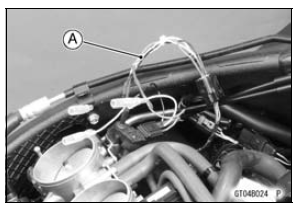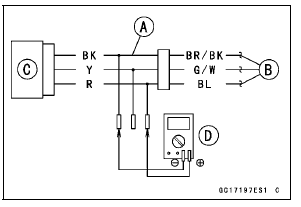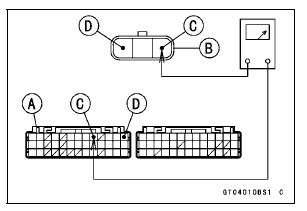

NOTE
Be sure the battery is fully charged.
[B] Main Harness
[C] Intake Air Pressure Sensor #2
Special Tool - Measuring Adapter: 57001-1700


Intake Air Pressure Sensor #2 Input Voltage Connections to Adapter: Digital Meter (+) → R (sensor BL) lead
Digital Meter (–) → BK (sensor BR/BK) lead
Input Voltage Standard: DC 4.75 ∼ 5.25 V
If the reading is within the standard, check the output voltage (see Intake Air Pressure Sensor #2 Output Voltage Inspection).
If the reading is out of the standard, remove the ECU and check the wiring for continuity between main harness connectors.
Special Tool - Hand Tester: 57001-1394

Disconnect the ECU and sensor connectors.
Wiring Continuity Inspection ECU Connector [A] ←→ Intake Air Pressure Sensor #2 Connector [B] BL lead (ECU terminal 9) [C] BR/BK lead (ECU terminal 13) [D]
If the wiring is good, check the ECU for its ground and power supply (see ECU Power Supply Inspection in the Fuel System (DFI) chapter).
If the ground and power supply are good, replace the ECU (see ECU Removal/Installation in the Fuel System (DFI) chapter).
 Intake Air Pressure Sensor #2 Installation
Intake Air Pressure Sensor #2 Installation Intake Air Pressure Sensor #2 Output Voltage Inspection
Intake Air Pressure Sensor #2 Output Voltage InspectionExploded View
25. “1T” marked side faces up.
26. “T2” marked side faces up.
27. Hollow mark faces exhaust side.
G: Apply grease.
L: Apply a non-permanent locking agent.
LG: Apply liquid gasket.
M: Apply molybdenum disulfide grease.
MO: Apply molybdenum disulfide oil solution.
...
Subthrottle Sensor Input Voltage Inspection
NOTE
Be sure the battery is fully charged.
Turn the ignition switch to OFF.
Remove the air cleaner housing (see Air Cleaner Housing
Removal in the Fuel System (DFI) chapter)
Disconnect the subthrottle sensor connector and connect
the harness adapter [A] between these connectors.
Spec ...
External Shift Mechanism Inspection
Examine the shift shaft [A] for any damage.
If the shaft is bent, straighten or replace it.
If the serration [B] are damaged, replace the shaft.
If the spring [C] is damaged in any way, replace it.
If the shift mechanism arm [D] is damaged in any way,
replace the shaft.
Check the s ...